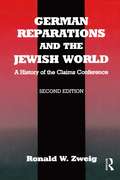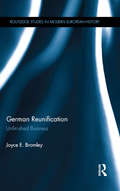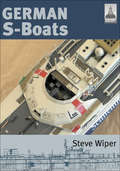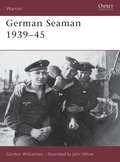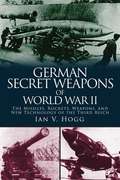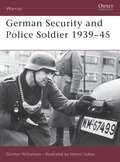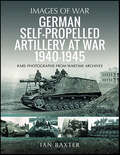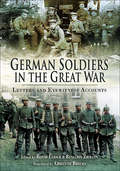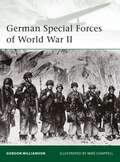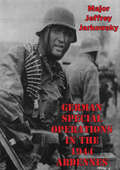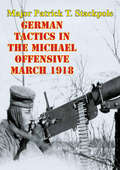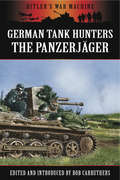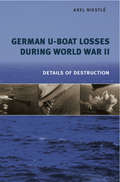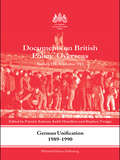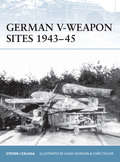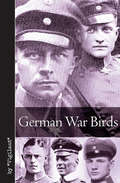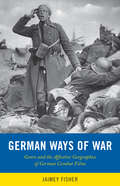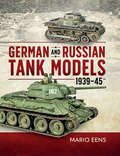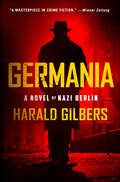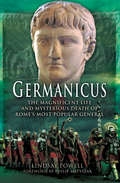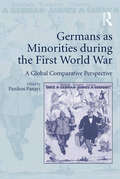- Table View
- List View
German Reparations and the Jewish World: A History of the Claims Conference
by Ronald W. ZweigGerman Reparations and the Jewish World" has become a standard reference work since it was first published. Based extensively on archival sources, the author examines the difficult debate within the Jewish world whether it was possible to reach a material settlement with Germany so soon after Auschwitz. Concentrating on how the money was spent in rebuilding Jewish life, he also analyzes how the reparations payments transformed the relations bteween Israel and the diaspora, and between different Jewish political and ideological groups. This revised and expanded edition includes material on sensitive relief programmes from archives that have only recently been opened to researchers. In a new, extensive introductory essay the author reexamines the reparations, restitution and indemnification processes from the perspective of 50 years later.
German Reunification: Unfinished Business (Routledge Studies in Modern European History)
by Joyce E. BromleyIn 1945, German families with more than 100 hectares (247 acres) of land were forced from their homes in the eastern sector by the Soviets, now in control of that area. These families were brutally evicted from their property and had their land expropriated. In the next 45 years, the GDR government would come to control all of the agricultural land. At reunification in 1990, the earlier abuse of these farmers was compounded when the German government would not restore any of this expropriated land to these families. The German government falsely accused the Soviet Union of insisting on non-restitution as a condition of reunification. Soviet leader Mikhail Gorbachev unequivocally denies this claim and insists that land issues are a German problem to resolve. The temporary land-trust agency, established by the German government in 1990 to dispose of land it inherited from the GDR, continues to exist. After 25 years, this agency still holds almost 20 percent of this expropriated land. Its agents, most of whom were reared in GDR, decide who may (or may not) lease land, the conditions of the lease, and if and when a farmer may buy land – circumstances that remain deeply controversial. Joyce Bromley draws on extensive field research, and previously untapped sources, to explore the reliability of the government’s version of these important events. Is the German government once again, without shame, discriminating against a group of its own citizens?
German S-Boats (ShipCraft)
by Steve WiperThe 'ShipCraft' series provides in-depth information about building and modifying model kits of famous warship types. Lavishly illustrated, each book takes the modeller through a brief history of the subject class, highlighting differences between sister-ships and changes in their appearance over their careers. This includes paint schemes and camouflage, featuring colour profiles and highly-detailed line drawings and scale plans. The modelling section reviews the strengths and weaknesses of available kits, lists commercial accessory sets for super-detailing of the ships, and provides hints on modifying and improving the basic kit. This is followed by an extensive photographic gallery of selected high-quality models in a variety of scales, and the book concludes with a section on research references—books, monographs, large-scale plans and relevant websites. The subject of this volume is the Second World War German Navy's motor torpedo boats called Schnellboote, known to the Allies as E-Boats. One of the most effective coastal attack craft of the time, the type was built in large numbers and constantly improved as the war progressed, giving many variants to interest modellers. With its unparalleled level of visual information—paint schemes, models, line drawings and photographs—it is simply the best reference for any modelmaker setting out to build one of these famous boats.
German S-Boats in Action in the Second World War
by Hans FrankA detailed narrative of S-boat, or schnellboot, actions during World War II in all the theatres where they were deployed. The author, describes, with the help of a multitude of maps and photographs, all the incidents that these 45-knot fast attack craft were involved in. The German motor torpedo boat (German: S-boot, English: E-boat) was a controversial subject in the pre-war period of German naval rearmament. As late as 1938, the Fleet Commander recommended that S-boot building be terminated on the grounds that the craft was merely a 'weapon of opportunity' without a defined role. This outlook changed dramatically after the first wartime successes. Soon the S-boot was required on all fronts, and the area of operations. In this volume the operational deployment of the S-Boot in these theatres is given comprehensive treatment for the first time, and not purely from the isolated viewpoint of S-Boot warfare, but as an integral part of the overall military objectives of the time. This study of the effectiveness of the S-Boot, its successes and failures, is based on war diary entries and previously unseen original sources. It is a first-class account of this German naval arm in which survived to be the last class of German surface warship still carrying the offensive to the enemy.
German Seaman 1939-45
by John White Gordon WilliamsonWhen re-armament came after World War I, the German Navy was forced to build anew, so the Reichsmarine and its successor, the Kriegsmarine, found itself in possession of some of the most modern, powerful and technically advanced vessels in the world. Germany was very selective in picking her sailors and the quality of manpower skill levels was thus very high. This book charts the recruitment, training, service conditions and combat experiences of a typical World War II German sailor, focusing on the main branches of the Navy, as well as the last ditch combat units thrown into action as infantry in the final days of the war.
German Secret Weapons of World War II: The Missiles, Rockets, Weapons, and New Technology of the Third Reich
by Ian V. HoggHitler’s regime was notorious for its many experiments and its various secret ploys, weapons, and technological developments. But typically, the term "secret German weapons” only turns up images of the V-1 and V-2 missiles that played a part in bombing London in 1944. But truth be told, there were many more unheard of weapons behind the Third Reich. Many of these weapons have been unknown to the general public. Here, Ian V. Hogg, one of the world’s leading experts on weaponry, reveals the sheer magnitude of Hitler’s secret weapon projects, from the V-3 and the V-4 missiles, to the Schmetterling, to the German nuclear bomb, to the question of nuclear war and more. This detailed account of the myths surrounding secret German weapons examines the various fields the Germans concentrated on during their weapon development process and discusses difficulties that arrived in the process and how, in many cases, the ideas were exploited by other nations.German Secret Weapons of the Second World War draws comparisons between similar Allied projects and narrates the deeper purpose behind many of these projects. Many of these developments were not completed before the end of the war, but have created a solid foundation for many of today’s great military developments. Skyhorse Publishing, as well as our Arcade imprint, are proud to publish a broad range of books for readers interested in history—books about World War II, the Third Reich, Hitler and his henchmen, the JFK assassination, conspiracies, the American Civil War, the American Revolution, gladiators, Vikings, ancient Rome, medieval times, the old West, and much more. While not every title we publish becomes a New York Times bestseller or a national bestseller, we are committed to books on subjects that are sometimes overlooked and to authors whose work might not otherwise find a home.
German Secret Weapons of the Second World War: The Missiles, Rockets, Weapons & New Technology of the Third Reich
by Ian V. Hogg&“A comprehensive, highly detailed study [that] displays a stunning wealth of technical knowledge . . . a brisk and understandable narrative.&” —HistoryNet The phrase &“German secret weapons&” immediately conjures up images of the V-1 and V-2 missiles that bombarded London in 1944. But what of the V-3 and V-4? What of Schmetterling, the Rochling shell, the Kurt bomb, the Hs293? These, and many other devices, were all part of the German secret armory, but are relatively unknown except to a handful of specialists. What of the German nuclear bomb? And the question of chemical warfare? The sheer magnitude of the secret weapon projects of the Third Reich is revealed in this comprehensive study written by one of the world&’s great experts on weaponry. The book explores the various fields in which the Germans concentrated their weapon development and discusses the multiplicity of ideas, the difficulties, and, in several cases, how these ideas were subsequently exploited by the victors. Although much of the German wartime development was not completed before the war&’s end, it nevertheless provided a foundation for a great deal of the munitions development that has since taken place. Comparisons with Allied projects are also drawn. This book explodes some of the myths surrounding Hitler&’s secret weapons to reveal a truth all the stranger for being fact. Includes photographs and line drawings
German Security and Police Soldier 1939-45
by Gordon Williamson Velimir VuksicThe security units of the Third Reich were many and diverse, yet often an oversimplified view is projected of these organisations. This title provides a detailed and informed picture of the variety of operations and duties, as well as the motivation and behaviour of the men involved. It charts the experiences of typical World War II security forces and police soldiers - from the routine of military traffic duty, to combating partisans and resistance fighters. It covers the military police of the Armed Forces proper and the Waffen-SS, the combat units of the German State Police, the SD Sicherheitsdienst, the Schutzmannschaft' units, and the extreme and dreaded anti-partisan units 'Dirlewanger' and 'Kaminski'.
German Self-propelled Artillery at War 1940–1945
by Ian Baxter“Easily recommended as an introduction to German self-propelled artillery of WWII, or as a modelling reference.” — Armorama Despite the German Panzerwaffe’s ability to engage its foes rapidly with concentrated force, additional fire power was often required to break through enemy lines. Initially this was with towed artillery but, as the war developed, converting tanks into fast-moving self-propelled artillery carrying vehicles proved far more effective. As a result a number of weapon systems came into service including the Pz.Kpfw.I and II. Other conversions followed including the Pz.Kpfw.II Wespe with its 10.5cm gun, the Pz.Kpfw.III/IV Hummel armed with a 15cm howitzer, the Sturmpanzer Brummbar with its powerful 15cm gun and the Grille series based on the Czech Pz.Kpfw 38(t) tank chassis. These and other armored vehicles were capable of providing both close firesupport for infantry and acting as anti-tank weapons. This highly illustrated book describes the key role played by German self-propelled artillery from its introduction in 1940 in France, to North Africa, Italy, Russia and North-West Europe. It analyzes the development of the numerous variants that came into service as these formidable weapon systems were adapted and up-gunned to face the ever-increasing enemy threat. With rare and often published photographs this book provides a unique insight into German self-propelled artillery from its early triumphant war years to final defeat in 1945.
German Soldiers in the Great War: Letters and Eyewitness Accounts
by Jay Winter Benjamin Ziemann Bernd UlrichThe first English translation of writings that capture the lives and thoughts of German soldiers fighting in the trenches and on the battlefields of WWI. German Soldiers in the Great War is a vivid selection of firsthand accounts and other wartime documents that shed new light on the experiences of German frontline soldiers during the First World War. It reveals in authentic detail the perceptions and emotions of ordinary soldiers that have been covered up by the smokescreen of official military propaganda about “heroism” and “patriotic sacrifice.” In this essential collection of wartime correspondence, editors Benjamin Ziemann and Bernd Ulrich have gathered more than two hundred mostly archival documents, including letters, military dispatches and orders, extracts from diaries, newspaper articles and booklets, medical reports and photographs. This fascinating primary source material provides the first comprehensive insight into the German frontline experiences of the Great War, available in English for the first time in a translation by Christine Brocks.
German Special Forces of World War II
by Mike Chappell Gordon WilliamsonOsprey's study of the troops that made up Germany's elite special forces of World War II (1939-1945). Such forces included the legenday Skorzeny Commandos who carried out such audacious tasks as the glider-borne rescue of Mussolini, and the kidnapping of the son of the Hungarian regent, Admiral Horthy. This book also includes details of lesser-known units such as the Brandenburgers, who operated behind enemy lines in captured uniforms, and the Kleinkampfverbände who were the forerunners of modern-day naval combat troops like the US Navy SEALs. Complete with uniform and kit detail together with action accounts of many of these daring operations, this book is a must-have for any special forces enthusiast.
German Special Operations In The 1944 Ardennes Offensive
by Major Jeffrey JarkowskyThis study is a historical analysis of the German special operations conducted in support of their overall Ardennes offensive. It focuses on the two major special operations of the German offensive, Operations "Greif" and "Stoesser." Operation Greif was the German attempt to infiltrate a commando unit behind American lines disguised as American soldiers. Operation Stoesser, the last German airborne operation of the war, was designed to secure a key cross-roads behind American lines. These special operations failed because of faulty planning, inadequate preparation, and a lack of coordination between the special and conventional forces. These problems, exacerbated by a lack of preparation time, resulted in a pair of ad-hoc units that were unable to accomplish their primary missions, although the operations were characterized by boldness, initiative, and improvisation. This study also examines the strategic setting, planning, preparations, and conduct of these operations, as well as their impact on the overall campaign. This study also examines the key lessons-learned that can be derived from both operations. Lastly, the study explores the implications of these lessons for the U.S. military of today.
German Tactics In The Michael Offensive March 1918
by Major Patrick T. StackpoleThis study investigates the German spring offensive of 1918 to determine how the Germans achieved tactical success, yet failed to reach their strategic objective. The study covers the development of new German infantry tactics during limited offensive operations and conduct of the "elastic defense" on the western front It investigates the development of artillery tactics on the eastern front, and the incorporation of these artillery and infantry tactics into larger scale offensives at Caporetto. The study describes the preparation of both the infantry and artillery units for the "Michael" offensive. The relationship between the infantry and artillery tactics combined with the British defense is the key to determine the causes for success and failure.The German tactical system used in "Operation Michael" was a brilliant adaptation to the lethality of the World War I battlefield. The German techniques were superb tools for conducting a breakthrough of a defensive zone. However, the lack of German mobility following the breakthrough foiled the German strategic goal to envelop the British Army.German techniques and lessons learned in this offensive have direct application to U.S. Army infiltration doctrine.
German Tank Hunters: The Panzerjäger (Hitler's War Machine)
by Bob CarruthersThis unique collection of contemporary combat accounts provides a primary source insight into the reality of anti-tank warfare on the Eastern Front. Both armoured and infantry based operations are considered.This book is part of the 'Hitler's War Machine' series, a new military history range compiled and edited by Emmy Award winning author and historian Bob Carruthers. The series draws on primary sources and contemporary documents to provide a new insight into the true nature of Hitler's Wehrmacht.The series consultant is David Mcwhinnie creator of the award winning PBS series 'Battlefield'.
German U-Boat Losses During World War II: Details of Destruction
by Axel NiestléA deep dive into the fate of German submarines lost during the Second World War. &“This has to be the best reference you can find on the subject.&”—Military Modelling No other publication on this subject comes even close to including the amount of detail provided in this book. An introduction both summarizes previous works on the subject and describes the difficulties of obtaining and verifying information from either the Germans or the Allies on U-boat losses. The main part of the book lists by hull number each U-boat&’s date of commissioning, its commanding officer, and the date and port of departure for its last patrol. It also gives the date, position, and cause of loss of each submarine, with complete details on Allied units involved in the sinking, the names and ranks of their commanding officers and pilots, and the number of crew killed or rescued. An appendix neatly summarizes data on the disposition of surviving U-boats at the end of the war and provides valuable statistical data on German U-boat losses. &“Highly recommended for every serious scholar of the Atlantic war, and every library in naval history and the history of the Second World War.&”—The Mariner&’s Mirror &“The level of detail is quite impressive and this edition is the result of 16 years of further research since the first edition . . . If you are seeking data on the fate of U-Boats then this book should be your &‘first place of call&’—no other book has such detailed data.&”—Military Archive Research
German Unification 1989-90: Documents on British Policy Overseas, Series III, Volume VII (Whitehall Histories)
by P. SalmonThis volume is comprised of a collection of diplomatic documents covering British reactions to, and policy towards, the collapse of the German Democratic Republic and the unification of Germany in 1989-90. The peaceful unification of Germany in 1989-90 brought a dramatic end to the Cold War. This volume documents official British reactions to the collapse of East Germany and the fall of the Berlin Wall, and the evolution of British policy during the ‘Two plus Four’ negotiations that provided the international framework for the merger of the two German states. All of the documents fall within the UK’s 30-year rule and have therefore not previously been in the public domain. Most are drawn from the archives of the Foreign and Commonwealth Office, but there are also a large number of Prime Ministerial files from the Cabinet Office archives. These are of particular interest for the light they throw on the views of Margaret Thatcher. Taken together, the documents show that despite Mrs Thatcher’s well-known reservations about German unity, the United Kingdom played a vital and constructive role in the negotiations that helped to bring it about. This volume will be of great interest to students of International History, British Political History, and European Politics and International Relations in general. Patrick Salmon is Chief Historian at the Foreign and Commonwealth Office. Keith Hamilton is a Historian at the Foreign and Commonwealth Office and Senior Editor of Documents on British Policy Overseas. Stephen Twigge is a Senior Historian at the Foreign and Commonwealth Office.
German V-Weapon Sites 1943-45
by Hugh Johnson Steven ZalogaDesigned to change the course of the war, the V-weapons required ambitious plans to defend their expensive and complicated launch sites. Steven J Zaloga describes the configuration and planned deployment of heavy missile sites, as well as the unique Allied tactics developed to counter this threat, including a remote-control version of the B-17 bomber. Covering the V-1 ski sites, the mobile units employed for V-2 launches and other secret weapons bases like the "V-3" high-pressure gun at Mimoyeques, he reviews the impact of these weapon systems and defenses not only on World War II but also on the development of modern weaponry. This book is an excellent guide to the sites described, many of which still survive and are visited on battlefield tours.
German War Birds (Vintage Aviation Library)
by Claude W. SykesDramatic true stories of air combat featuring Germany&’s greatest pilots: &“AWorld War I aviation history classic&” (Over the Front). In these riveting accounts, Manfred von Richthofen, Max Immelmann, Oswald Boelcke, and other famous daredevil flyers are joined by lesser-known but equally resourceful colleagues such as Rudolf von Eschwege and Hans Schüz as they take part in furious battles in the sky—and close escapes on the ground when brought down on the wrong side of the lines. German War Birds contains some of the earliest information to appear after the war about air combat in the Middle East and Russia, as well as the Western Front, and about the significance of observation balloons as targets that were viciously attacked. The author focuses on the heart of the action and recreates the experiences of the airborne war with immediacy and excitement—drawing the reader into events as they happen.
German Ways of War: The Affective Geographies and Generic Transformations of German War Films (War Culture)
by Jaimey FisherGerman Ways of War deploys theories of space, mobility, and affect to investigate how war films realize their political projects. Analyzing films across the decades, from the 1910s to 2000s, German Ways of War addresses an important lacuna in media studies: while scholars have tended to focus on the similarities between cinematic looking and weaponized targeting -- between shooting a camera and discharging a gun – this book argues that war films negotiate spaces throughout that frame their violence in ways more revealing than their battle scenes. Beyond that well-known intersection of visuality and violence, German Ways of War explores how the genre frames violence within spatio-affective operations. The production of novel spaces and evocation of new affects transform war films, including the genre’s manipulation of mobility, landscape, territory, scales, and topological networks. Such effects amount to what author Jaimey Fisher terms the films’ “affective geographies” that interweave narrative-generated affects, spatial depictions, and political processes.
German and Russian Tank Models, 1939–45
by Mario EensThis fully illustrated guide offers step-by-step instructions for building detailed models of German and Russian WWII tanks. This comprehensive guide is invaluable for tank modelers of all skill levels. It includes tips and techniques for building models scaled at 1/72, 1/48 and 1/35. Expert modeler Mario Eens also provides a wealth of information on the tools, paints and techniques needed to give your models an accurate and realistic finish. With this guide at your side, you&’ll be able to recreate the Russian T-34 at the time of the battle of Kursk, and the Su-152 in winter camouflage, as well as the German Panzer I in North Africa, and the gigantic Maus, as it might have appeared just after the war ended.
German-East Asian Encounters and Entanglements: Affinity in Culture and Politics Since 1945 (Routledge Studies in Modern History #75)
by Joanne Miyang ChoThis volume surveys transnational encounters and entanglements between Germany and East Asia since 1945, a period that has witnessed unprecedented global connections between the two regions. It examines their sociopolitical and cultural connections through a variety of media. Since 1945, cultural flow between Germany and East Asia has increasingly become bidirectional, spurred by East Asian economies’ unprecedented growth. In exploring their dynamic and evolving relations, this volume emphasizes how they have negotiated their differences and have frequently cooperated toward common goals in meeting the challenges of the contemporary world. Given their long-standing historical differences, their post-1945 relations reveal a surprisingly high degree of affinity in many areas. To show how they have deeply shaped each other’s views, this volume presents 12 chapters by scholars from the fields of history, sinology, sociology, literature, music, and film. Topics include cultural topics, such as German and Swiss writers on East Asia (Enzensberg, Muschg, and Kreitz), Japanese writer on Germany (Tezuka and Tawada), German commemorative culture in Korea, Beethoven in China, metal music in Germany and Japan, diary films on Japan (Wenders), as well as sociopolitical topics, such as Sino– East German diplomacy, Germans and Korean democracy, and Japanes and Korean communities in Germany.
German-occupied Europe in the Second World War (Routledge Studies in Second World War History)
by Raffael Scheck Fabien Théofilakis Julia TorrieInspired by recent works on Nazi empire, this book provides a framework to guide occupation research with a broad comparative angle focusing on human interactions. Overcoming national compartmentalization, it examines Nazi occupations with attention to relations between occupiers and local populations and differences among occupation regimes. This is a timely book which engages in historical and current conversations on European nationalisms and the rise of right-wing populisms.
Germania: A Novel of Nazi Berlin
by Harald GilbersFrom international bestselling author Harald Gilbers comes the heart-pounding story of Jewish detective Richard Oppenheimer as he hunts for a serial killer through war-torn Nazi Berlin in Germania.Berlin 1944: a serial killer stalks the bombed-out capital of the Reich, preying on women and laying their mutilated bodies in front of war memorials. All of the victims are linked to the Nazi party. But according to one eyewitness account, the perpetrator is not an opponent of Hitler's regime, but rather a loyal Nazi. Jewish detective Richard Oppenheimer, once a successful investigator for the Berlin police, is reactivated by the Gestapo and forced onto the case. Oppenheimer is not just concerned with catching the killer and helping others survive, but also his own survival. Worst of all, solving this case is what will certainly put him in the most jeopardy. With no other choice but to futher his investigation, he feverishly searches for answers, and a way out of this dangerous game.
Germanicus: The Magnificent Life and Mysterious Death of Rome's Most Popular General
by Lindsay Powell&“The story of a Roman Emperor that might have been&” (Fighting Times). Germanicus was regarded by many Romans as a hero in the mold of Alexander the Great. His untimely death, in suspicious circumstances, ended the possibility of a return to a more open republic. This, the first modern biography of Germanicus, is in parts a growing-up story, a history of war, a tale of political intrigue, and a murder mystery. In this highly readable, fast paced account, historical detective Lindsay Powell details Germanicus&’s campaigns and battles in Illyricum and Germania; tracks him on his epic tour of the Eastern Mediterranean to Armenia and down the Nile; evaluates the possible causes of his death; and reports on the cruel fate his wife, Agrippina, and their children suffered at the hands of Praetorian Guard commander, and Tiberius&’s infamous deputy, Aelius Sejanus.
Germans as Minorities during the First World War: A Global Comparative Perspective
by Panikos PanayiOffering a global comparative perspective on the relationship between German minorities and the majority populations amongst which they found themselves during the First World War, this collection addresses how ’public opinion’ (the press, parliament and ordinary citizens) reacted towards Germans in their midst. The volume uses the experience of Germans to explore whether the War can be regarded as a turning point in the mistreatment of minorities, one that would lead to worse manifestations of racism, nationalism and xenophobia later in the twentieth century.
